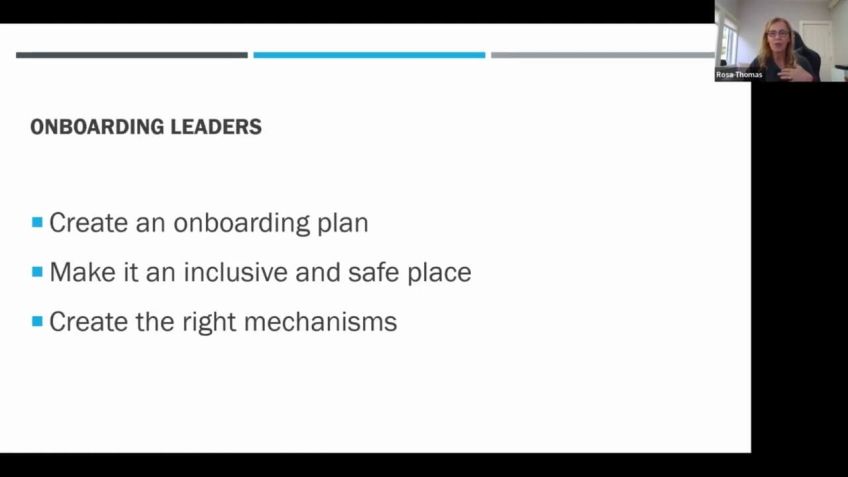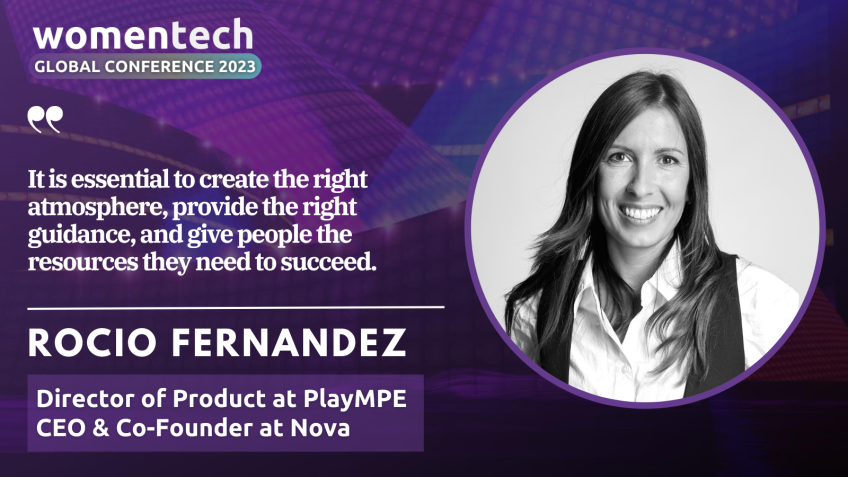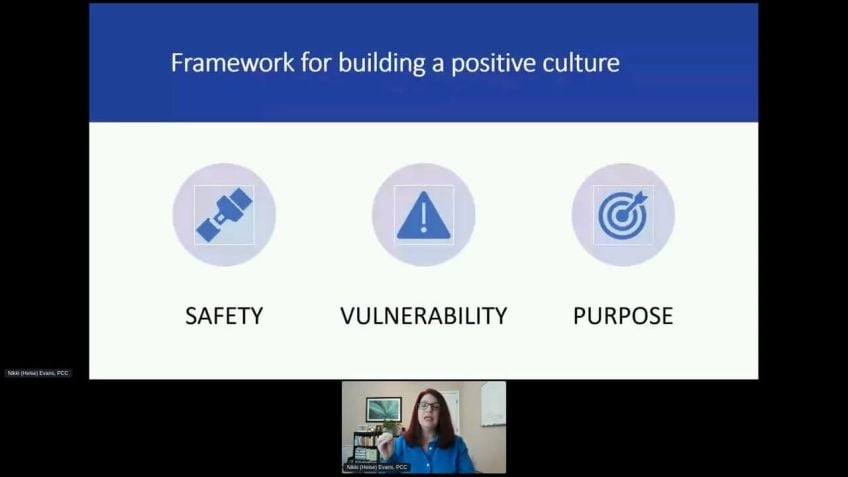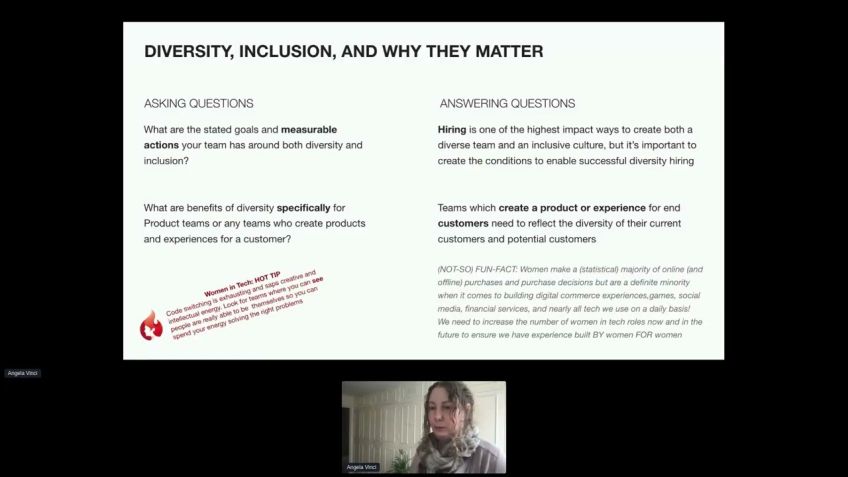Years that Ask and Years than Answer: Building a Team Culture Actively & Inclusively by Angela Vinci
Team Culture, Diversity, Inclusion, and Their Impact on Women in Tech
In today's fast-paced world of technology, understanding and embracing diversity and inclusion are as important as the technology itself. In this discussion, we aim to comprehend the core of building an inclusive and team-oriented culture that would emphasize the importance of diversity and the role of women in the tech industry.
Team Culture: The Defining Factor
Every team and company is unique, with its own set of ideals, goals, and culture. The 'company culture' is often described by nice words on company websites or striking presentation slides, but what truly defines it is the choices made and the outcomes of those decisions.
As tech professionals, it's crucial to evaluate if the culture of a company aligns with your personal values. Can you truly be yourself at work? Would you feel comfortable and happy in such an environment? These are important queries when considering potential job offers or evaluating your current position.
As a team leader, you should strive to create a culture that boosts the positive facets of your organization while establishing new ones that feel more in sync with your team. However, always remember, if there's a key mismatch in values, you can only progress so far.
Why Diversity and Inclusion Matter?
Ask yourself, does your team have stated goals and measurable actions around diversity and inclusion? These two intertwined concepts are essential for creating an environment where everyone feels welcome and comfortable to be their true selves.
Further, observe your surroundings. Is your product team or teams who create products representative of the diversity in the larger population? After all, it's imperative that the makers reflect their consumers' diversity for an inclusive and efficient product design.
Moreover, it is essential to create a safe and accepting space for all tech professionals, especially women. With diversity initiatives like Farfetch's 'Plug in' program, we can support eager tech enthusiasts straight out of university, ensuring a diverse and dynamic tech future.
Creating an Inclusive Environment
Achieving active inclusion often involves asking profound questions like - Who is responsible for ensuring that an inclusive environment is the norm? To this, the answer lies in leadership. Leaders need to model inclusive behavior and invite participation from everyone, making it a norm rather than an exception.
Creating a space where everyone feels safe to ask tough questions, even in public forums, forms the foundation of an inclusive environment. It's alright if not everyone is comfortable speaking first or speaking up. There are multiple ways to engage and support ideas, such as voicing agreement or reinforcing a statement that you concur with.
Wrapping up
Remember, the first and foremost step towards an inclusive, diverse, and team-oriented tech culture begins with you. Be it as a participant or a leader, your questions, agreements, disagreements, and interactions can pave the way for a culture that truly values and appreciates everyone. Together, let's create an all-embracing tech space for everyone, especially women, and redefine tech culture.
Thank you for joining this discussion. Feel free to ask questions and let's continue to connect in the future!
Video Transcription
Thank you for letting me speak with you today and share what I think is a really important topic. But um I will call it the highlights reel since it's a short session, wanna touch on a few things today.And hopefully we'll be able to generate some great follow up conversations and connections from this. So what we'll cover is the idea around what is important with building a team culture actively and inclusively and hit on three big parts of that. First is company and team culture.
Second is diversity and inclusion and why they matter. Probably everyone here knows that, but it's good to check in and then third, talk about what active inclusion really looks like. So I am going to start with a quote from one of my all time favorite books and it might seem a bit odd to start with a quote um that maybe no one has heard of um from a book that might be a bit obscure or maybe you have, in which case we are already friends. But this is from an American author called Zora Neale Hurston and she was a black woman writing in the US in the 19 thirties. And it might seem a bit odd to talk about an author from sort of the early parts of American history. And how does that relate to women in tech today? But the book talks about and is really based on a woman who is finding herself and not accepting what society told her she was or she had to be and ultimately carving out her own place in the world. And I honestly can't think of something that is more relevant for women navigating the world and the world of tech today. So with that, um would love to jump into the important content, starting with company culture and team culture. So first and foremost, how does your company describe its culture? So throughout this presentation, I'm going to go between asking some provocative questions and touching on the answers. Obviously, these don't cover everything.
But the reason I'm using this framework is I think it is really important to talk to, to speak to this group about how asking and answering questions are important throughout our careers and obviously throughout our whole lives. Um And we'll talk through how each one of these questions is important to women in tech and how the answers can really help you navigate the space that we're in and help think about how you make choices for yourself and for others. So first, I would start with how does your company describe its culture? And we've probably all seen plenty of powerpoint index and nice words on company websites or organization websites if you work in the nonprofit space. Um and sometimes those things are the same but very often they're not. So if you want to really look at a company culture, you need to look at the choices and the outcomes of these choices, not just the words that are said. Um I will share when I was looking to join Farfetch, I did a huge amount of research. Um It was a very big decision. I wasn't sure I wanted to stay in tech. To be honest, I've been in the space a long time and was really looking for something that was going to make me feel like I had an impact and was, was able to do some good work in the world.
Um which might not sound logical if you're thinking about sort of luxury or digital retail, but a lot of the work is about connecting with people and creating things. So one of the things that I did was watch every single video that was created by an employee about what it was like to work at far fetch. And the thing that jumped out to me the most and still sticks to me this day is how many people said I can be myself at work. And I think if you are looking for understanding a culture of a company, you need to think about if you can be yourself there and what that means. So as you navigate sort of looking at your current job, job or company and potential futures really dig into culture because culture makes all the difference in how successful and how happy you can be in a place. So the second question is really, how would you describe the culture you want to create for your team?
And how does that align with the company culture, you can create a team culture which amplifies the most positive aspects of your company culture and even has positive aspects that aren't there in the company if you are really thoughtful and work hard to build that. But ultimately, if there is a mismatch in those values, you can only get so far. So I think it is really important as a woman in technology to be thoughtful about those choices because it will affect how you feel about your job today, but also how much you can be successful in the future. So think about the idea of how are you placing yourself in a company but in a culture and is that setting you up to succeed? Not just now, but in the future. Um I also have a little hot tip on every slide. So today's hot tip for this one is really do look at companies as a network and make sure you have or you can easily find a set of people. So when we have people join my team, we set them up with a buddy and a mentor and an advocate. Usually that's your manager. And I would also say, look for an aspirational leader who can inspire you personally. I think we all know representation matters.
So making sure that there's someone who you can aspire to be like that is someplace that you feel like I'm represented is important and that's not always easy as a woman in tech as we know. So next diversity and inclusion and why they matter. Again, I think we all know that they do, but I think it's also important to dig in a little bit about the specifics. So the first question is really what are the stated goals and measurable actions your team has around both diversity and inclusion because while they're related, they are separate things. And I would say as a hiring manager or leader at any level that hiring is one of the most high impact ways you can have on creating a diverse team for obvious reasons, but also an inclusive culture. But it doesn't just happen automatically, you have to really thoughtfully and actively think about the conditions that help you attract the right people, but make it comfortable for people to be who they actually are at work and to feel welcome in that environment. So we do a lot in my team to think about how we're doing that. It is naturally a more a fairly inclusive place.
Um far fetched, I think has an advantage of being a global company and therefore we have not one single correct point of view, there's lots of different points of views, there's lots of different, I think nationalities, cultures, languages. And so it starts us off on a more level playing field from right from the start. But I think again, really important as you're thinking about how to find your place now and later to look at what is actually happening. Um If we think about also the second question about the benefits of diversity specifically for product teams or teams who create products and experiences for a customer. And I use customer very broadly, that could be sort of end customer. If you think about digital retail or commerce can also be B to B customers, it can be customers within your own business. But you are creating something for a, a person or a group of people. And my team creates the experience for what we call the far fetched marketplace, all the sites and apps and anything you can see and interact with. And it is my opinion and my team's opinion that it's actually the most important place for us to ensure that we've got a good diversity of talent and different points of view because we are creating for a global population.
So really being able to reflect that diversity, not just of sort of background, but we have a lot of discussions around things like accessibility around different cultural points of view, how things are actually very different, depending on where you are located in the world and how do we accommodate that?
And I think having a group of people who not just know that that's important, but really care about entering into that dialogue is really important. And I think again, I'm using products very broadly because tech is a big field. Um So anyone who's part of that chain who creates something should be really part of being involved in. How are we making sure that we're representative? Um I also included a not so fun fact on this, that I think it's a good thing for us to think through as we're trying to build a pipeline for the future. Um And think about today is women make a statistical majority of both online and offline purchases and purchase decisions, but we are still a definite minority when it comes to building those experiences. Certainly on the digital side in commerce and games and social media and financial services.
Pretty much all the tech we use, that's not representative and we're not going to get the best experience unless we have women showing up in those spaces. So we need to look at both today and tomorrow and think about how we're increasing the number of women in all kinds of tech roles. So that could be engineering, it could be design, it could be product management could be analyst roles. There's, it's a it's a large field, but so far fetch has a great program called the Plug in program where we work with basically students coming right out of university and we bring them into the team and have them do various like set them up with very specific roles so that we can give them training.
And most of the time we convince them to stay and we love having them. Um But we also need to think about people who are here today and how are we creating a really accepting and safe environment for women and just a generally inclusive environment so that not just people coming up will want to be here, but they have a place where they can feel at home and they can feel successful.
Um My hot tip on this one is I think code switching is absolutely exhausting it, saps creative energy and intellectual energy. So if you are searching, look for teams where you can see people that are really able to be themselves and don't have to waste energy pretending to be someone else so that you can expend that on actually solving fun and interesting problems at work. And last but not least active inclusion. So creating the space and inviting people in. So two things I think are important. One is starting with asking the big question of whose job is it to make sure that an inclusive environment is the norm and not the exception. And that might sound strange but um I think there is a wide array array of variability in sort of not just cultures but teams specifically. And I do think this is a place where leadership roles in particular have a responsibility. So leaders and the more senior you are, the more important this is need to model that inclusive behavior. And I think, and this is just my opinion also to be vulnerable. I think there's a, a little bit of myth around the more senior you are, the more you're supposed to know everything and sort of be, you know, uh unstoppable and, and never having anything get to you.
And I think that's not true and kind of sets everybody up to feel like they can't be honest when they're struggling. So being able to create an environment where people can not just feel included, but also be honest when they need help is important. And as a leader, you have to actively and visibly seek input and invite participation. So this can be as simple as just inviting people really directly asking their opinion, having them speak up very often. Women are the ones who are quiet because societally, we're often conditioned to be more quiet or men are just rewarded for speaking up more and more supported. When they're actively jumping into things, we need to be thoughtful about making sure to make that space and really invite people in often. This is women or people who might have, you know, could be coming from a different place where it's not their native language or culturally, it's not as encouraged. So we have to be thoughtful about how you really open that space up for participation. And then second, what does inclusion really look like? And as a leader specifically, how do you know if people on your team really do feel included?
So I will say the thing I look for is a place where people feel safe speaking up and asking for what they need is the foundation. So people should all be able to ask hard questions. Also hard questions in public forums. Um This might sound like a weird one, but I think it's a really good indicator of how secure do people feel in their role, not just in the company, but in your team that they can ask things that might be difficult. And um my team is really great at that and they ask a lot of hard questions to me. They ask a lot of hard questions in some of our bigger public forums for it across far fetch. Um And to be honest, I thank them and I'm always really proud because I feel like it speaks volumes that people feel secure and are willing to also put themselves out there to ask those tricky questions. So my hot tip on this one though is speaking up or speaking first, might not be comfortable, comfortable for everybody, but that's OK. Um Another thing you can do is voice agreement or reinforce a statement that you agree with and that's a great way to support and elevate ideas that you believe in but also other people.
So I think it's, it, there are many, many paths to get to that place of inclusion and to create for leaders to create the right culture, but also for everyone to participate and reinforce the things that are important and that we care about. And with that, I know that was a bit of a whirlwind tour, but I will stop. So there is a little bit of time for questions. Hopefully there are some huge thank you to everyone who joined and I hope that we can connect in the future. OK. Thanks Madalena. All right, bye, everyone. Have a great day. Enjoy the rest of the conference.




